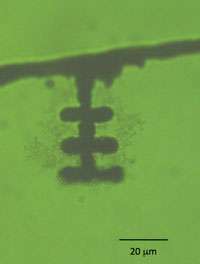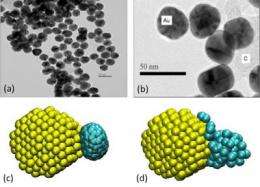Using light to build nanoparticles into superstructures

Scientists in the Center for Nanoscale Materials and Argonne's Biosciences Division have demonstrated a remarkably simple, elegant, and cost-effective way of assembling nanoparticles into larger structures of any desired shape and form at will via a process called "optically directed assembly."
Optically directed assembly (ODA) involves suspensions of gold and carbon nanoparticles in water. A small droplet of the suspension is placed on a glass slide, and a low-power laser is focused onto a small region within the droplet near its surface. Through a complex process involving optical trapping, heating, evaporation, convective fluid flow, and chemical interactions, the nanoparticles fuse near the laser focus and as the experimenter moves the laser focus around in the droplet, a continuous filament of the fused material follows.

These remarkable structures remain completely intact even after the fluid is drained off. In this manner “handcrafted” filaments of up to millimeter lengths and 10-60 times wider than the original nanoparticles can be formed with arbitrary shape and design. The resulting hierarchical architectures may be useful for a variety of applications, including biological sensing, electronics, optics, and emerging energy technologies. As a first demonstration, the researchers handcrafted a microscopic glyph -- the Chinese symbol for “king.”
Irreversible metal-metal aggregation is observed only when carbon is present. Scientists in CNM's Theory & Modeling Group used molecular dynamics simulations to model gold-carbon nanoparticle configurations and wetting behavior.
More information: J. T. Bahns et al., “Optically Directed Assembly of Continuuous Mesocale Filaments,” Phys. Rev. Lett., 106, 095501 (2011). (online) DOI: 10.1103/PhysRevLett.106.095501
Provided by Argonne National Laboratory


















